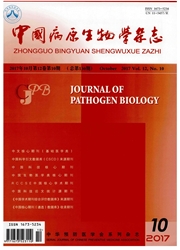

 中文摘要:
中文摘要:
目的鉴定对弓形虫感染具有潜在诊断价值的弓形虫抗原分子。方法制备刚地弓形虫RH株速殖子全虫可溶性蛋白及弓形虫感染小鼠腹腔蛋白,经SDS-PAGE分离后采用半干电转移方法将其转移到硝酸纤维素膜上,再分别与22份弓形虫感染者血清进行Western blot,以22份健康人血清和其他寄生虫病患者血清作为对照,筛选能被弓形虫感染者血清特异性识别的蛋白组分;两种蛋白样本经二维电泳分离后采用Western blot筛选能被弓形虫感染者混合血清识别,但不能被健康人血清及其他寄生虫病患者血清识别的特异性斑点。切取SDS-PAGE胶上相应的特异性蛋白质斑点进行MALDI-TOF分析,鉴定蛋白斑点的基因。结果一维电泳及Western blot结果显示,弓形虫感染小鼠腹腔蛋白中的90、37、30、28和18ku组分分别可被部分弓形虫感染者血清识别,其中为28ku蛋白能被22份弓形虫感染病人血清中的15份所识别;速殖子全虫可溶性虫体蛋白中的90、70、67、56、48、39、37、30、28和18ku组分可被部分弓形虫感染者血清识别,其中28ku蛋白可被22份弓形虫感染者血清中的21份识别,22份健康人血清中有2份与28ku蛋白呈弱阳性反应,与其他寄生虫病患者血清无交叉反应。二维电泳Western blot阳性斑点的飞行质谱分析显示,弓形虫感染小鼠腹腔蛋白中的28ku组分为磷酸丙糖异构酶,弓形虫速殖子全虫可溶性蛋白中的28ku组分为GRA2和GRA7。结论弓形虫抗原与宿主抗体反应具有高度异质性,GRA2、GRA7及磷酸丙糖异构酶等分子的弓形虫感染者血清识别率高,此三种蛋白可作为建立具有高敏感性的弓形虫病特异性免疫诊断方法的抗原分子。
 英文摘要:
英文摘要:
Objective To characterize antigen molecules with the potential to diagnose infection with Toxoplasma gondii. Methods Soluble protein from tachyzoites of T.gondii(RH strain)and peritoneal protein from mice infected with T.gondii were prepared.After one-dimensional SDS-PAGE,components of soluble protein from tachyzoites and peritoneal protein were transferred to nitrocellulose membranes by semi-dry transfer.Strips of the nitrocellulose membrane were incubated with sera from 22 patients with toxoplasmosis and then subjected to Western blotting.Sera from healthy individuals and patients with other parasitic diseases served as controls in order to screen for protein components that were specifically recognized by sera from patients with toxoplasmosis.After two-dimensional electrophoresis,the protein spots were screened using Western blotting to identify spots that reacted specifically with pooled sera from patients with toxoplasmosis but not with sera from healthy individuals and patients with other parasitic diseases.The protein spots in SDSPAGE gels that corresponded to protein spots in 2-dimensional electrophoresis were removed and analyzed using MALDITOF to determine the encoding genes coding for proteins that produced the protein spots. Results One-dimensional e-lectrophoresis and Western blotting indicated that the 90,37,30,28,and 18-ku components of the peritoneal protein were recognized by sera from some patients with toxoplasmosis.The 28-ku component was recognized by sera from 15of22 patients with toxoplasmosis.The 90,70,67,56,48,39,37,30,28,and 18-ku components of the soluble protein from tachyzoites were recognized by sera from some patients with toxoplasmosis.For example,the 70,56,and 39-ku components were all recognized by sera from 5of 22 patients with toxoplasmosis.The 28-ku component was recognized by sera from 21 of 22patients with toxoplasmosis.In contrast,the 28-ku component reacted weakly to sera from 2of 22 healthy individuals.The 28-ku component was not recognized by sera from patients with
 同期刊论文项目
同期刊论文项目
 同项目期刊论文
同项目期刊论文
 Monitoring specific antibody responses against the hydrophilic domain of the 23 kDa membrane protein
Monitoring specific antibody responses against the hydrophilic domain of the 23 kDa membrane protein Detection of the circulating antigen 14-3-3 protein of Schistosoma japonicum by time-resolved fluoro
Detection of the circulating antigen 14-3-3 protein of Schistosoma japonicum by time-resolved fluoro Characterization of IgG responses of rabbits to Sj14-3-3 protein after experimental infection with S
Characterization of IgG responses of rabbits to Sj14-3-3 protein after experimental infection with S 期刊信息
期刊信息
